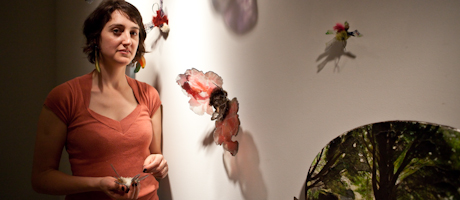By Menachem Wecker
Over lunch one day, Clarice Smith, B.A. ’76, M.F.A. ’79, and Lenore Miller, M.F.A. ’72, director of university art galleries and chief curator, were brainstorming about exhibition ideas. Mrs. Smith recommended a show on contemporary photography. Ms. Miller agreed on the spot to developing an exhibition for the Luther W. Brady Art Gallery.
More Photographs Than Bricks, which is at the Brady Gallery from March 24 to April 30, is the second of three exhibits supported by Mrs. Smith, who was on the faculty at GW’s Department of Fine Arts and Art History from 1980 to 1987. The first show was “The Academic Tradition: Teaching and Practice,” which was on exhibit at the Brady Gallery in fall 2008.
According to Ms. Miller, the current show builds upon some of the genres laid out in the 2008 exhibit: history, portraiture, genre, landscape and still life. More Photographs than Bricks features 23 pieces, including various applications of photography and sculpture.
In a sense, a 2004 work by Japanese artist Yasumasa Morimura serves as a microcosm for the larger show. One has to get very close to “Vermeer Study (A Great Story out of the Corner of a Small Room)” to realize it is a color photograph on canvas rather than a hyperrealist painting. The image is part of a larger trend in Mr. Morimura’s work, where he inserts himself into renowned paintings. Interesting anachronisms ensue.
The photograph is based on the 1666 “Allegory of Painting” by Dutch painter Johannes Vermeer (of “Girl with a Pearl Earring” fame), which shows an artist, with his back to the viewer, painting a model. Some scholars say Vermeer inserted himself into the work as the painter, but in Mr. Morimura’s work, there is no denying that the artist has appended his face to the model’s body.
Mr. Morimura has made a few other changes, including adding a camera to the table in front of the model. The contemporary reference in an otherwise 17th-century environment is jarring, as is Mr. Morimura’s decision to swap Vermeer’s map of Holland for a world map underscored by images of flags of the different nations.
“The complexities of photography’s interaction with painting have grown as the barrier between the mediums has evaporated in the postmodern period,” writes Virginia Adams, a professor at the Maryland Institute College of Art, in the catalog essay “Beneath Every Picture: Photography in the 21st Century.”
According to the gallery Web site, the exhibit, which includes work by 15 artists, is divided into five themes: appropriation and the historicized portrait, new horizons of the panoramic landscape, utopia and utopias lost, landscape and still life and the collector (of images).
One artist included in the show is Ana Labastida, who grew up in Mexico and now lives in Berkeley, Calif. Ms. Miller first learned about Ms. Labastida’s work, which uses recycled glass and cement to create sculptures of moths, when she was invited to visit a private collection. She noticed a glass moth on the wall, and asked about it. She learned that the moth was created by her hosts’ daughter-in-law, and she visited Ms. Labastida on her next trip to Berkeley.
Ms. Labastida, who was installing her work when GW Today previewed the exhibit, says she uses “urban materials” to achieve delicateness in her work. In 2008, she decided to create moths, because they are generally considered ugly, she says. She buys the glass from recycling companies and uses a diamond saw to cut the pieces to the right sizes. Ms. Labastida also affixes photographs she has taken to the wings of the moths.
The moths’ bodies are made of concrete, and Ms. Labastida attaches powerful magnets “to their bellies,” which cling to metal washers affixed to the wall. This allows Ms. Labastida to rotate the moths, and she considers the potential to readjust the work (and the patterns of light reflected on the wall) an important component of her work.
Other notable works in the show are portraits of artist Kara Walker and model Kate Moss by Chuck Close, a National Medal of Arts winner, and “Four Towers” by Sean Scully, whose series of paintings Wall of Light exhibited in 2005 at the Phillips Collection.
Nancy Breslin’s “6.29.05. Snack at the Tate Modern, London,” which is included in the show, comes from GW’s permanent collection. The photograph, which was made through a pinhole exposure, shows a view out a window looking out on the Thames River. A dark drink and a catalog with the name Frida Kahlo sit on a table in front of the window.
Whereas classical artists often conceived of the canvas as a window for viewers to look through, abstract artists in the 20th century began thinking of the painting surface as a flat space. Ms. Breslin’s photograph – taken from inside an art museum looking out through a window on the London cityscape – might symbolize a new direction, showcasing how modern photographers are questioning and reinterpreting the boundary between photography and painting.


